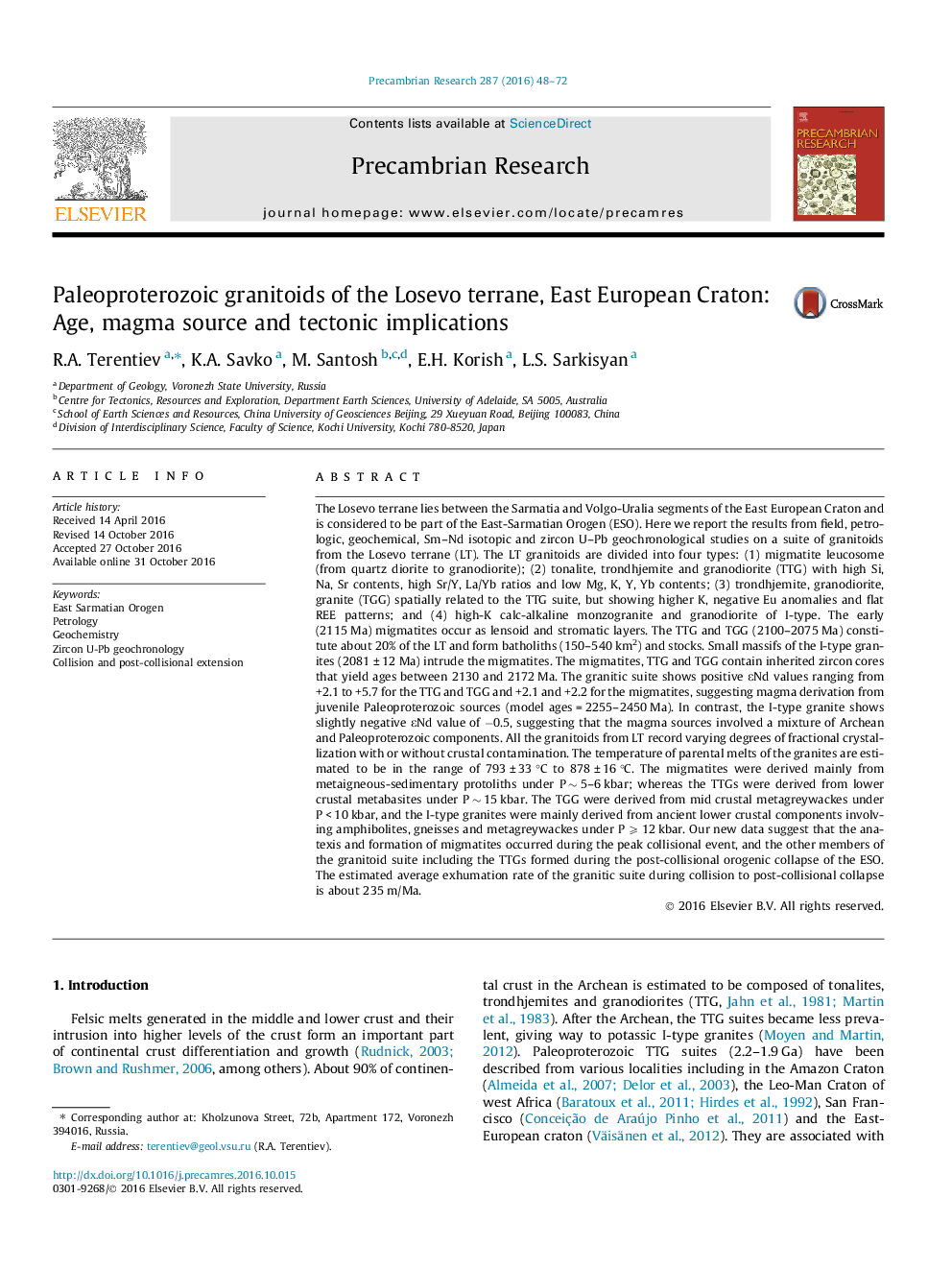| کد مقاله | کد نشریه | سال انتشار | مقاله انگلیسی | نسخه تمام متن |
|---|---|---|---|---|
| 4722269 | 1639588 | 2016 | 25 صفحه PDF | دانلود رایگان |
• Four groups of granitoids with distinct petrological and geochemical features.
• Zircon U-Pb ages range from 2115 Ma to 2081 Ma.
• εNd values suggest juvenile Paleoproterozoic sources.
• Magma generation in peak to post-collisional tectonic setting.
The Losevo terrane lies between the Sarmatia and Volgo-Uralia segments of the East European Craton and is considered to be part of the East-Sarmatian Orogen (ESO). Here we report the results from field, petrologic, geochemical, Sm–Nd isotopic and zircon U–Pb geochronological studies on a suite of granitoids from the Losevo terrane (LT). The LT granitoids are divided into four types: (1) migmatite leucosome (from quartz diorite to granodiorite); (2) tonalite, trondhjemite and granodiorite (TTG) with high Si, Na, Sr contents, high Sr/Y, La/Yb ratios and low Mg, K, Y, Yb contents; (3) trondhjemite, granodiorite, granite (TGG) spatially related to the TTG suite, but showing higher K, negative Eu anomalies and flat REE patterns; and (4) high-K calc-alkaline monzogranite and granodiorite of I-type. The early (2115 Ma) migmatites occur as lensoid and stromatic layers. The TTG and TGG (2100–2075 Ma) constitute about 20% of the LT and form batholiths (150–540 km2) and stocks. Small massifs of the I-type granites (2081 ± 12 Ma) intrude the migmatites. The migmatites, TTG and TGG contain inherited zircon cores that yield ages between 2130 and 2172 Ma. The granitic suite shows positive εNd values ranging from +2.1 to +5.7 for the TTG and TGG and +2.1 and +2.2 for the migmatites, suggesting magma derivation from juvenile Paleoproterozoic sources (model ages = 2255–2450 Ma). In contrast, the I-type granite shows slightly negative εNd value of −0.5, suggesting that the magma sources involved a mixture of Archean and Paleoproterozoic components. All the granitoids from LT record varying degrees of fractional crystallization with or without crustal contamination. The temperature of parental melts of the granites are estimated to be in the range of 793 ± 33 °C to 878 ± 16 °C. The migmatites were derived mainly from metaigneous-sedimentary protoliths under P ∼ 5–6 kbar; whereas the TTGs were derived from lower crustal metabasites under P ∼ 15 kbar. The TGG were derived from mid crustal metagreywackes under P < 10 kbar, and the I-type granites were mainly derived from ancient lower crustal components involving amphibolites, gneisses and metagreywackes under P ⩾ 12 kbar. Our new data suggest that the anatexis and formation of migmatites occurred during the peak collisional event, and the other members of the granitoid suite including the TTGs formed during the post-collisional orogenic collapse of the ESO. The estimated average exhumation rate of the granitic suite during collision to post-collisional collapse is about 235 m/Ma.
Figure optionsDownload as PowerPoint slide
Journal: Precambrian Research - Volume 287, December 2016, Pages 48–72
